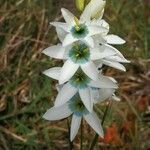Grass-like, tufted. Corm flattened-globose, ± 1.5 cm diam., tunic fibrous, light brown. Stems 30-120 cm high, slender or stout. Leaves 5-8, ± = stems, 2-8 mm wide. Inflorescence simple or laxly branched with 2-4 erect or ± spreading branches, main axis with 15-30 close-set flowers, branches with up to 10 flowers; spathe-valves c. 7 mm long, membranous, white occasionally violet-tinged and violet-veined. Flowers 2-3 cm diam., pale violet-blue or blue tinged with pink, white at centre with yellow patch; tube 0.5-1 cm long; lobes 1-1.5 cm long, outer with darker central purple stripe at back. Capsule 2.5-3 mm long, oblong to globose, brownish.
Herb 30-100 cm tall. Corm to 2.5 cm diam. Leaves 5-8, erect, linear, 20-60 cm long, 2-6 mm wide. Stem unbranched or with 1-4 erect branches. Spike ±distichous, open or dense, few-many-flowered. Bracts ovate or oblong, very shortly dentate, 3-7 mm long, translucent, whitish, often faintly veined. Flowers white or pale blue to mauve-pink, the centres often a contrasting colour. Perianth tube filiform, 6-14 mm long; lobes spreading from base, obtuse, 1-2.5 cm long, 5-9 mm wide. Filaments 3-4 mm long; anthers 4-7 mm long. Ovary 2-3 mm long; style branches spreading below anthers, recurved, 3-4 mm long.
Cormous geophyte, 40-80 cm, corms with stolons. Leaves linear to sword-shaped. Flowers crowded terminally, white, pink or mauve, or yellow often with darker centre, sometimes yellow, tube filiform, rarely faintly fragrant.

